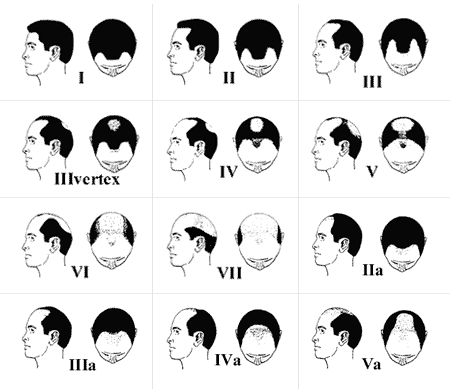Genetic Code Catching Up
In a previous post you said “Remember, hair loss is progressive and either with Propecia or Avodart, sooner or later your genetic code will catch up with you.”
What do you mean about genetic code catching up with you even if you take Propecia or Avodart?
Thank you for drawing attention to my cryptic medical speak. This is best explained by using an example.
First, it is important to show the Norwood Classification chart, so that the readers here can see what I am referring to.

Now, let us assume that your genetics will eventually take you to become a Class 6 patterned hair loss, but now you show only a Class 4 pattern because you are still losing hair and have not arrived at the final hair loss pattern you may have inherited from your family. In some people, their hair loss is so slow that they progress from the Class 3, to a Class 4, to a Class 5 and so on. The change can take years and be very slow to occur. In other unfortunate people, the loss may first show as thinning in the Class 6 pattern and then advance to a complete Class 6 pattern within a couple of years. If you are that Class 4 pattern person and take Propecia, the size of the bald spot in the back of your head may become smaller and the hair in the top may fill in a bit. You may go backward on this chart from a Class 4 to a Class 3 Vertex pattern, or you may regrow your thinning Class 6 pattern to a full head of hair with Propecia alone. If you stay on Propecia for life, maybe you will stay at a Class 3 Vertex, or you may slowly progress to a Class 4 or 5 or possibly 6 pattern over your lifetime (it could take 20-30 years or so to get there). If you got back the thinning hair in the 8 months that it takes for Propecia to act, you could lose it again, finding yourself back to ‘square one’ as the progressive nature of the hair loss continues to take its toll on you. We do not know if drugs like Propecia will stop the Class 6 pattern that you were destined ‘genetically’ to become, but it is not unreasonable, with what we know of today’s medications and what we know about Propecia, to actually see the value of this medication decrease with time. That means that the drug may eventually become less effective in preventing the progressive nature of the hair loss.
Avodart is a stronger medication for blocking DHT, and maybe by the time Propecia stops working for you, the FDA will clear Avodart for use in preventing hair loss. More likely, however, some new medication that is more effective than either of these drugs may come to market. It is my hope that medical research will continue to improve the effectiveness of medications for hair loss prevention or regrowth. What we must do now is to be patient, use what is there and what is safe, keep our fingers crossed and use the transplant ‘card’ when you are not satisfied with what you can achieve with drugs.
For people who have a Class 6 pattern and do not like it (or a lesser pattern hair loss which can be seen in over two hundred patient pictures at newhair.com), for example, they can become more hairy and reduce their balding appearance to a Class 3 or possibly even a Class 2 pattern if they have the donor hair to do it. That is what I mean by the hair transplant ‘card.’ We live at a wonderful time, where a simple outpatient surgery can transform a patient from a Class 6 to a Class 3 pattern in just a single surgery (under the right conditions). That means, between modern medications or hair transplantation, you can take charge of your life and your ‘hairy’ appearance. Remember, you are in the driver’s seat, so drive carefully.

Reader Comments0
Share this entry
Leave a Comment
Want to join the discussion? Feel free to contribute! Note: We do not tolerate offensive language or personal attacks to other readers. Marketing links or commercial advertisements will be deleted.